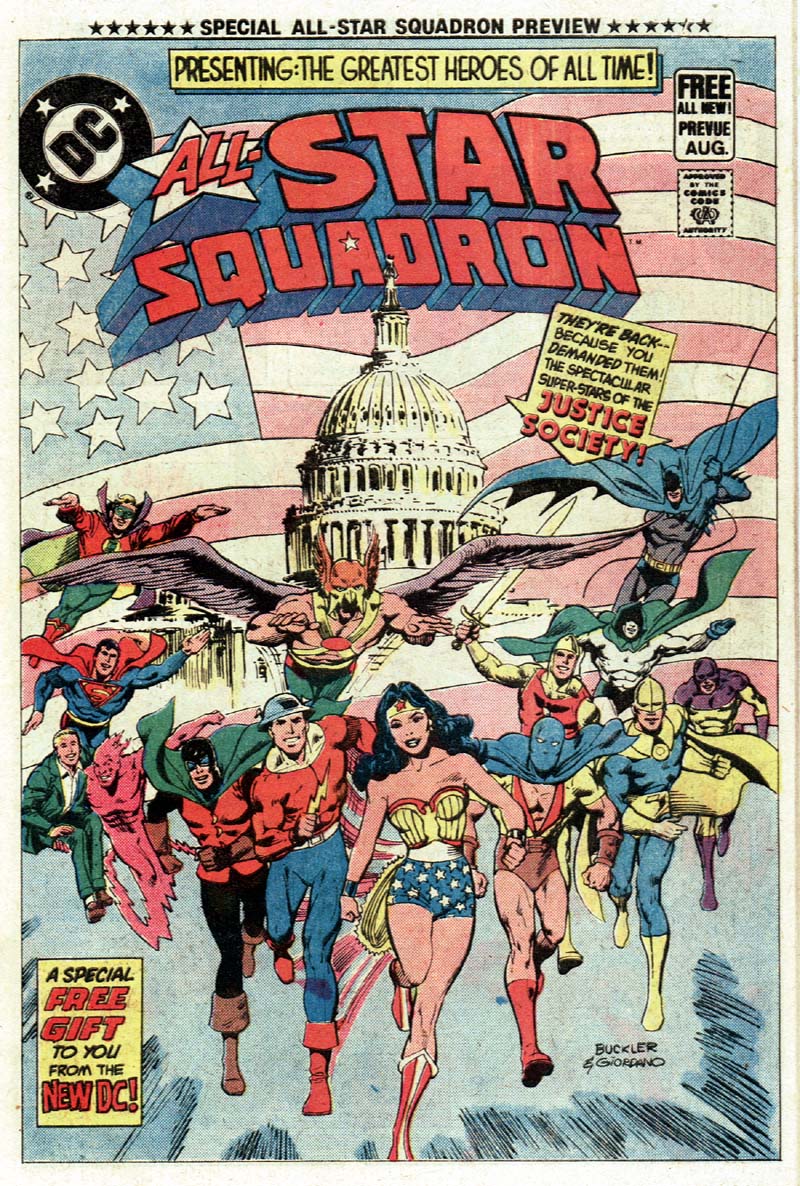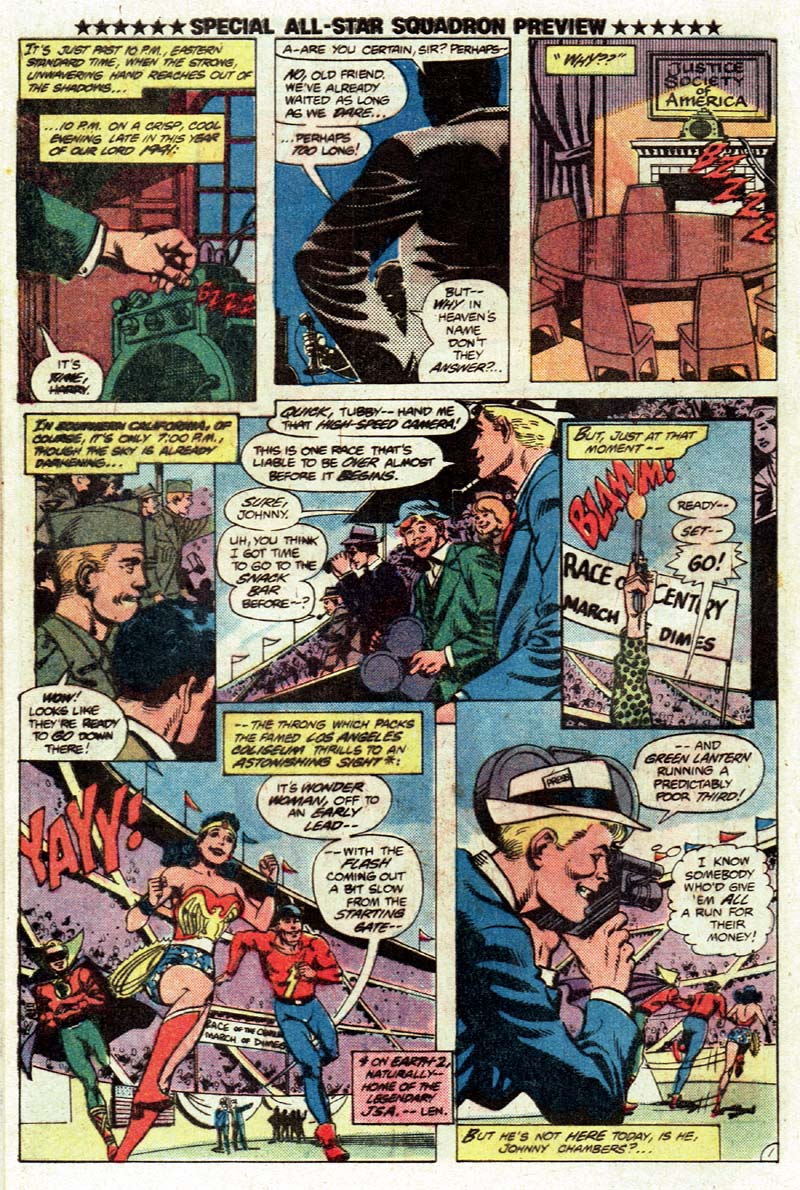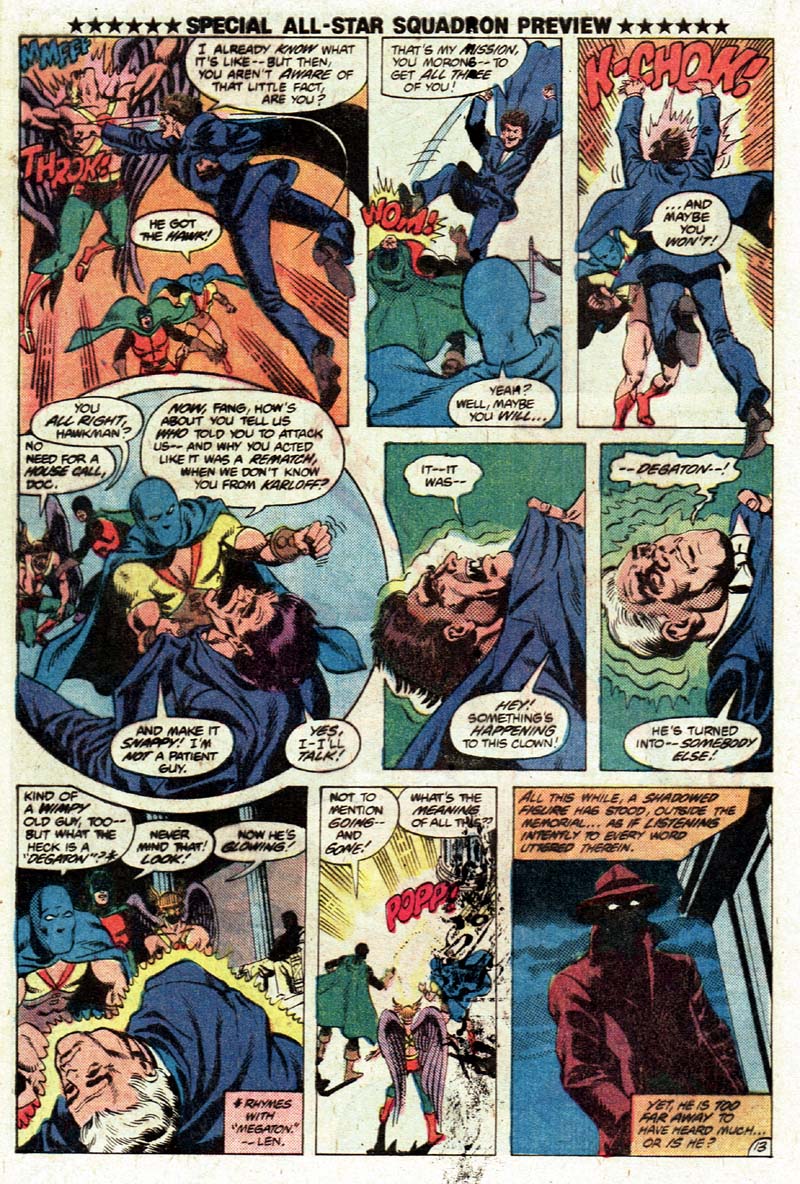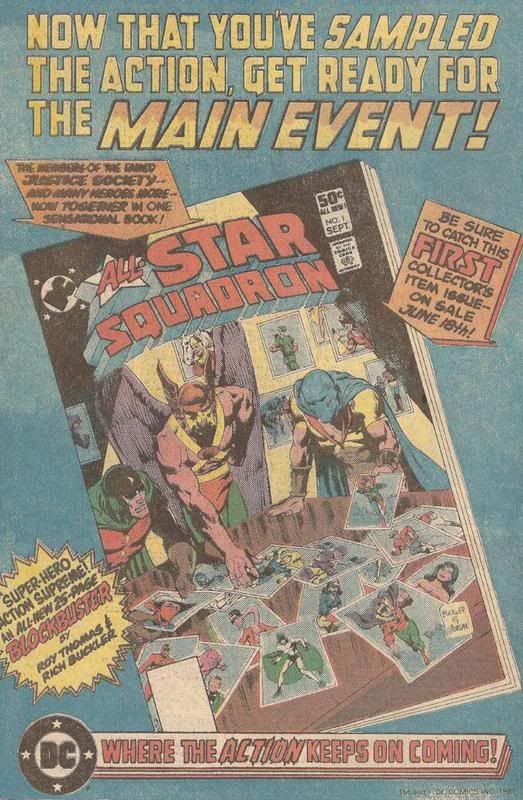Justice League of America #193, All-Star Squadron Preview
Perez cover and interiors, as the JLA learn the true secret origin of Red Tornado. But, who cares about that when there is a special 16-page preview of the All-Star Squadron inside?
 Creative Team:
Creative Team: Roy Thomas-writer, Rich Buckler-pencils, Jerimiah Ordway-inks (SIC), John Costanza-letters, Carl Gafford-colors, Len Wein-editor.
Gee, never heard of this Jerimiah Ordway guy; wonder if he is any good?
 Synopsis:
Synopsis: !941, in the evening, a shadowed figure on the East Coast tells Harry that it is time to make the call and we see a radio beeping in the JSA HQ, but no one is there. We cut to the West Coast, where a special celebrity race is underway, for the March of Dimes. The participants are the Flash, Green Lantern and Wonder Woman. Ses All?tells All News camerman Johnny Chambers is there to capture it for release as a newsreel, in theaters. The gun sounds and Wonder Woman gets and early lead and wins the race. She questions Flash about throwing the race and he retorts that he simply underestimated her and she got off the blocks quicker. Wildcat, standing in for World Heavyweight Boxing Champion Ted Grant, presents a trophy to the amazon.

The crowd goes wild and starts to mob the field and the heroes depart and relocate to LA's cho Park, for a picnic, where the two JSA members get to know the new girl on the block, Wonder Woman. They are soon interrupted by Solomon Grundy, who wants pants, too!
The JSAers have never heard of Solomon Grundy. Grundy say heroes lie. Solomon Grundy smash up heroes. Solomon Grundy kill all Super Friends. Whoops, Solomon Grundy jumping gun a few decades.
Grundy throws a tree at Green Lantern, surprising him that he knows about the ring's weakness against wood. WW tries the lasso and Grundy is immune and HITS A GIRL!!! GL is aghast and is royally irked that a swamp monster would hit a weak, defenseless girl. Grundy punches him out, too, then Flash goes down. Grundy is about to kill them when a mysterious voice in his head orders him to bring the heroes back.
Meanwhile, our shadowy figures still can't reach the JSA. Harry asks about that new group, the Law's Legionnaires (later renamed the Seven Soldiers of Victory) and his boss says the JSA is their best hope and tries again. In New York, Wesley Dodds, Ted Knight (not the narrator of the Super Friends debut season) and Johnny Thunder are watching the new=fangled television, as reporter Libby Lawrence signs off from her broadcast. The see a flying sailing vessel and change into Sandman, Starman and, um...Johnny Thunder and fly off to see what's going on. Well, Johnny's Thunderbolt flies them up there. They discover that the pirate ship is actuually a dirigible, painted to look like a pirate ship (um, it'd take a bit more than that to create the illusion, given the shape of your average airship). They land in the gondola and Johnny gets knocked on the noggin and bye-bye Thunderbolt. Sandman and Starman fight the goons, when some Errol Flynn wannabe, called Sky Pirate attacks the lubbers, with a gas propelling flintlock, which takes out the other two heroes.
We cut to Salem, Mass, where Kent and Inza Nelson observe Wotan attacking his tower, via his crystal ball and Dr Fate flies out to intercept him. Wotan fires magic bolts at him and Fate ignores them and crashes into his foe, only for Fate and the Spectre to both crash from the sky, as Wotan looks on, from behind a tree. He collects the fallen mystical men.
In the South Pacific, Navy Ensign Rod Reilly gets some leave from his ship to visit his geologist sister, who is observing volcanic activity. In Gotham City, Superman, batman and Robin are entertaining at a USO establishment, when it is attacked by a weird plane and an alchemist, Professor Zodiak. He hurls a liquid at Batman and Robin and they are regressed to childhood. Superman attacks and the Prof uses the Philosopher's Stone to subdue him. The rock is actually a piece of a green meteorite.
In Washington, our shadowy figure calls an FBI agent and sends him to find the JSA. Across town, Atom, Dr Midnite, and Hawkman are visiting the lincoln memorial, when they are attacked by The Monster. They defeat him and he murmurs a name, Degaton, as he passes out and reverts to the form of an old man, before disappearing. A figure in a trench coat and hat observes from afar.

He walks on and we hear a clock chime, as we cut to the White house, where our shadowy figures are revealed to be Harry Hopkins (head of the WPA and Roosevelt's right-hand man) and President Franklin Delano Roosevelt. They have been trying to reach the JSA to form the nucleus of a national defense force, a sort of All-Star Squadron, in the wake of a decoded message from the Japanese, which Roosevelt says means war. He worries about the absence of the JSA, as tensions are high.
We end with a shot of the Sunday morning Washington Globe being dropped off at a newsstand, with the headline about a National Rail Strike, set to begin on Sunday, Dec. 7, 1941!
Thoughts: Now this is how you preview a new series! In 16 jam-packed and fast paced pages, Roy shows us the members of the JSA being taken out by adversaries they have never met, yet seem to know all about them. Everyone goes down, except the Atom, Dr Midnite and Hawkman. We also meet Danette Reilly, sister of Ensign Rod Reilly, who seems to get a lot of favors from his ship, for a lowly "Butter Bar." (ensign). We see newsreel cameraman Johnny Chambers, who knows someone who could give the Flash a run for his money, as well as Libby Lawrence, who hosts one of the very early tv broadcasts. Two shadowed figures, one and FBI agent; and, the other, some guy in a trenchcoat are also involved. What the heck is going on? Well, we are told we have to pick up All-Star Squadron #1, on sale June 18th, 1981.

Solomon Grundy would not meet Green Lantern until 1944, Prof Zodiak first appeared in in 1948, the Monster in 1944, Sky Pirate in 1947. So, all of these villains are in the wrong time. The monster mentions Degaton, a name which will be further explored in issue #1.
Dannette Reilly is a brand new character, created by Roy and based on his wife Dann, who is a red-head. Her brother, Rod, is the alias of Quality Comics' Firebrand, one of their early mystery men, drawn by Reed Crandall, with red pants and a see-through red shirt, in one of the more bizarre ideas of the Golden Age costumers. Firebrand turned up late in the short-lived Freedom Fighters comic, having run off to Earth-1 ahead of the FF, and has to live with the fact that he was a "deserter" from the war against the Axis Powers, who controlled Earth-X.
Cameraman Johnny Chambers is secretly speedster Johnny Quick, who uses a mathematical formula to gain super-speed. It is later retconend that Johnny really uses that as a mantra to focus the Speed Force. TV pioneer Libby Lawrence is the masked Liberty Belle, one of the early DC heroines, though she didn't appear until late 1942. Roy is pushing up her debut a bit a bit, so that she can be part of the team. Of our two unrevealed figures, one is a DC character and one is a Quality Comics character, who will be revealed in the first issue.
Rich Buckler employs his Neal Adams-influenced style in this and newcomer Jerimiah Ordway's inks make it look really great. Buckler was mostly doing covers and the odd story, at DC, plus special projects like Superman vs Shazam. Roy said he liked Buckler's style here more than his Kirby-influenced work at Marvel, as he felt this was closer to the real Buckler. Buckler would move on from DC to running Archie's revival of its Red Circle imprint and their superheroes, the Mighty Crusaders and similar characters.
This comic made you want to rush out and grab that first issue, with the house ad teasing that iconic cover, since homaged/ripped off by many.
The "cover" of the preview presents an intriguing tease, as we see Shining Knight, of the Law's Legionnaires with the JSA members, instead of Starman. Shining Knight will play a role in this series; but, he only appears in one panel, when Harry Hopkins mentions the Law's Legionnaires.
The race at the beginning is an homage to the cover of Comic Cavalcade #1. The USO event is an homage to the cover of Worlds Finest #6.
On the last story page, the trenchcoat-clad mystery man stares off at the Washington Monument. Buckler mistakenly drew the figure staring at the Iwo Jima monument, which didn't exist yet. Roy had Jerry Ordway fix the panel.
Len Wein was the editor on record; but, Roy said he was pretty much hands off, in terms of putting together the book. However, Wein would assign the new artist, when Buckler left, instead of Roy making the decision, though Roy had no problems with Adrian Gonzales.
Historical Notes: This is set on December 6, 1941. On Dec 4, secret "war plans" had been leaked to the Chicago Tribune and Washington Times-Herald. The Rainbow 5 Plan, featured the US allied with Britain and France, against Germany, with a Europe-first strategy. Ultimately, it would be the blueprint for the US military's overall strategy. On Dec 6, FDR made a personal appeal to Emperor Hirohito to avoid war, as tensions were near the breaking point and reports from the Pacific identified Japanese build up of forces. These events and others convinced many, at the time and since, that FDR had foreknowledge of the attack on pearl Harbor and was working towards bringing the US into the war in Europe. There was still strong isolationist sentiment, which kept the US officially neutral, but, things like the Lend Lease Act created official ways around that neutrality. In that sense, FDR knew it was likely that the US would eventually be embroiled in the war, due to strategic and economic alliances. The Japanese issue is more complex, as the US had closely followed the Japanese military build up and acts of aggression in the Pacific, ever since the Russo-Japanese ar saw Japan emerge as a world power, with stunning naval victories. It was no secret that resource-deprived Japan desired the mineral wealth of China and the South Pacific European colony islands to help fuel their military might and to spur on industry. The US had been playing war games for years, in the Pacific Fleet, revolving around Japanese aggression against US territories and/or allied colonies. The US had broken the Japanese Diplomatic Code, though it wasn't completely open, as much still had to be inferred. This left such intel as still skeptical, until verified by other sources.
Roy uses this idea to show anxiety within FDR and his reason for reaching out to the JSA. he feels war on the horizon and wants to use America's mystery men as a powerful weapon to defend the country.
I haven't turned up any notation of a National Rail Strike set for Dec 7, 1941; but, a strike was earmarked for Sept. 15 of that year. Not sure about whether that was just something thrown in to show America did not see war, in the headlines for the morning papers on Dec 7 or whether Roy got his dates wrong.
Harry Hopkins was a close personal friend and trusted advisor to FDR. He ran the WPA and other New deal projects and was one of the chief architects of the New Deal. He was suffering from stomach cancer and looking to step down, when the war made him indispensable. Some believed that Hopkins was intended to be Roosevelt's successor, when his health issues derailed those plans. Regardless, he was a major figure of the era and is a logical liason for the president and the JSA.
Television broadcasts did exist, in a few major cities and was showcased at the 1939 New York World's Fair. TV sets were the toys of the very rich, so it is fitting that playboy Wesley Dodds has one. Libby Lawrence was a reporter, in her debut, but for newspaper and radio. Roy extends it into tv, to show that she is a popular figure and to show that tv did exist before the war; but would be mostly delayed for wider broadcast until after the war.
The March of Dimes was founded by Roosevelt in 1938, as the National Foundation for Infantile Paralysis. The more widely known name came from Radio and nightclub entertainer Eddie Cantor, who made appeals on behalf of the efforts to sell lapel pins for 10 cents. Soon, cards and letters were sending dimes to the White House and Cantor's appeals resulted in $85,000 being raised. After this, the annual fundraising drive consisted of encouraging children to send in one dime to help fight polio, the main thrust of the early efforts. This funding was used to develop the Salk Polio Vaccine. Such charity appeals were often featured in Golden Age comics and the JSA often revolved stories around charities and other appeals for aid.